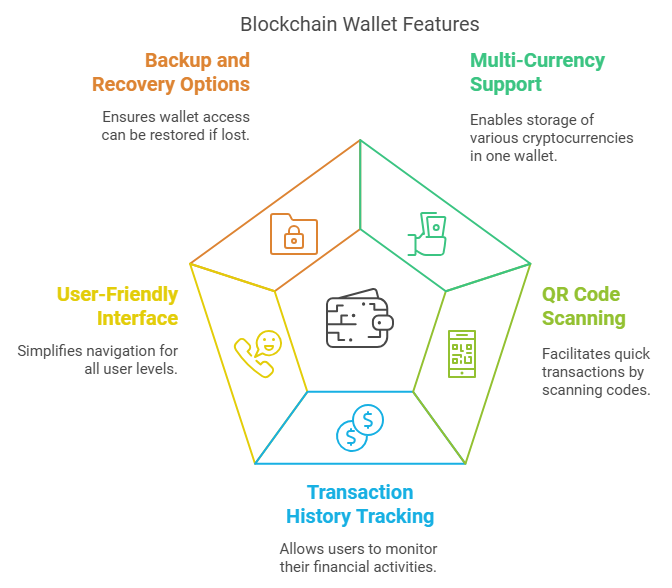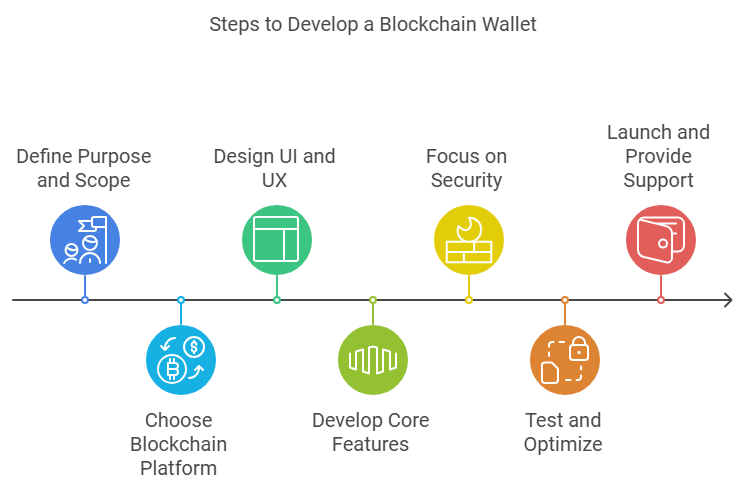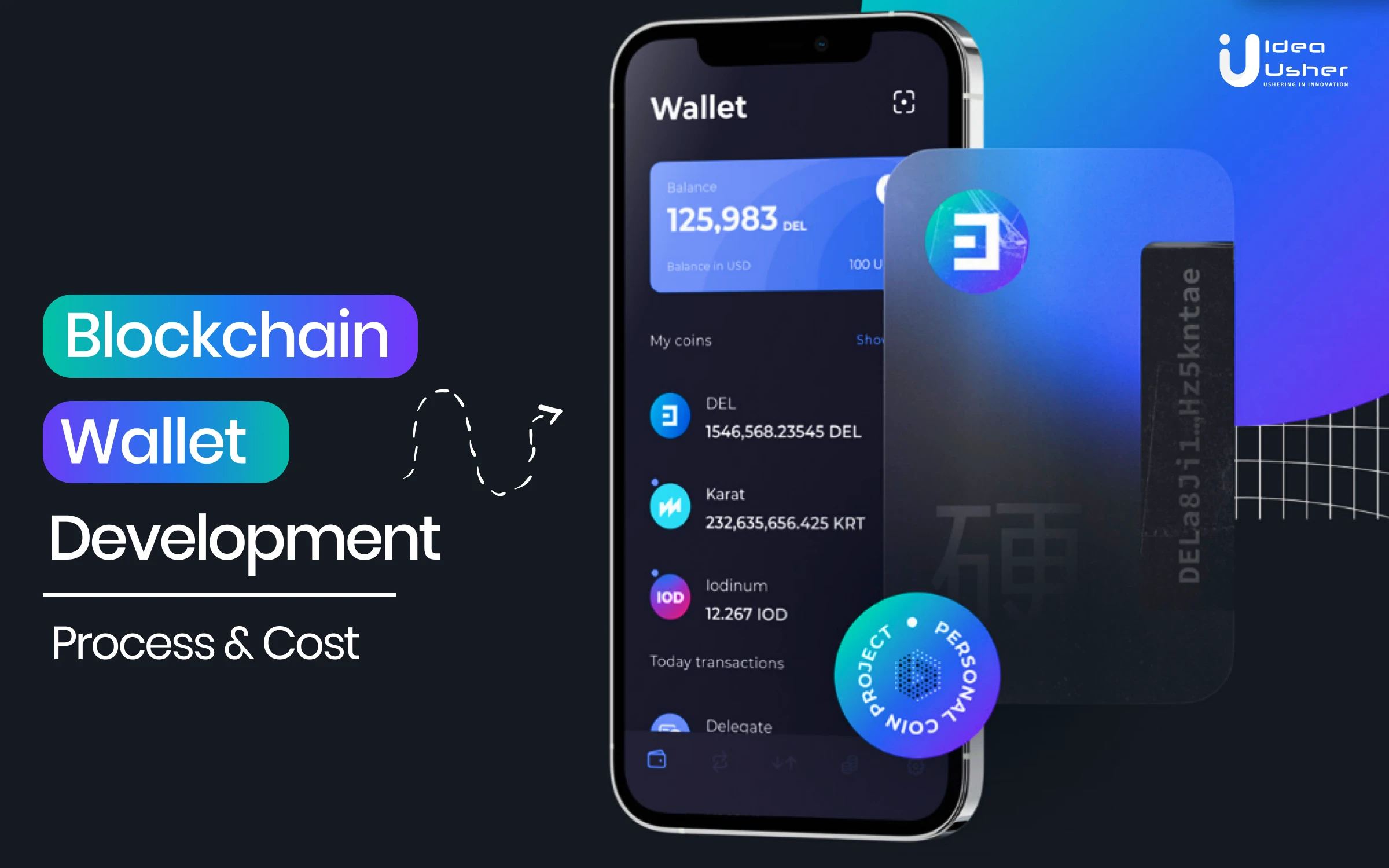Blockchain wallet development is revolutionizing how we store, access, and manage digital assets in the fast-evolving digital economy. These wallets are the backbone of blockchain technology, enabling users to send, receive, and securely store cryptocurrencies. With the growing adoption of blockchain in industries like finance, healthcare, and gaming, the demand for secure and user-friendly wallet solutions is surging. The importance of blockchain wallets extends beyond storing digital currencies. They play a critical role in empowering individuals and businesses to participate in DeFi, tokenized asset management, and smart contract transactions.
According to recent reports, the global blockchain wallet market is projected to grow at a CAGR of 24.6% from 2021 to 2026, underscoring its pivotal role in the decentralized ecosystem. As cybersecurity threats rise, the need for wallets with advanced encryption and robust security measures has become essential. This blog explores the process of blockchain wallet development and provides insights into the associated costs, helping businesses and entrepreneurs build secure, scalable, and feature-rich wallet solutions.
Key Market Takeaways of Blockchain Wallets
Source: GrandViewResearch
The trading segment led the market, accounting for over 40% of revenue, driven by the widespread use of crypto wallets for cryptocurrency trading. As decentralized cryptocurrencies are more vulnerable to cyberattacks, crypto wallets offer a secure solution for storing personal keys, further boosting their demand. The remittance segment is projected to experience the highest growth as consumers increasingly use cryptocurrency for cross-border payments to avoid high fees charged by traditional services. Initiatives like Felix Pago’s integration with Circle’s payment technology are expected to accelerate the growth of the cryptocurrency remittance market.
In 2022, the individual segment dominated with over 61% of revenue, driven by cryptocurrency’s popularity as a store of value. Despite their volatility, cryptocurrencies offer high returns, attracting technologically inclined users. The commercial segment is expected to grow the fastest as businesses adopt crypto for competitive advantages and advanced payment options. The increasing use of crypto wallets in industries like BFSI, gaming, and retail is fueling the segment’s growth.
Work with Ex-MAANG developers to build next-gen apps schedule your consultation now
What is a Blockchain Wallet?
A blockchain wallet is a digital tool that allows individuals to securely store and manage their cryptocurrencies and interact with blockchain networks. It acts as an interface between the user and the blockchain, facilitating the sending, receiving, and storage of digital assets like Bitcoin, Ethereum, and other tokens. It stores a pair of cryptographic keys called public keys and private keys.
- Public Key: Functions like an account number others use to send funds to the wallet.
- Private Key: A secret key that proves ownership of the funds in the wallet, enabling the user to authorize transactions.
The security of a blockchain wallet depends heavily on safeguarding the private key. If a private key is lost or compromised, the funds in the wallet are irretrievable.
Types of Blockchain Wallets
Blockchain wallets are categorized into two main types: hot wallets and cold wallets. These classifications are based on the method of storage and the level of connectivity to the internet.
Hot Wallets
Hot wallets are connected to the internet and are commonly used for frequent transactions. They are highly accessible, making them a popular choice for active traders and users who need quick access to their funds. The key features of hot wallets are:
- Instant access to funds
- Ideal for daily transactions
- User-friendly interfaces
- Vulnerable to online threats like hacking
Cold Wallets
Cold wallets, in contrast, are offline wallets that store private keys on a device or medium not connected to the internet. This makes them highly secure and ideal for long-term storage of cryptocurrencies. The key features of cold wallets are:
- Offline storage for enhanced security
- Resistant to online hacking attempts
- Less convenient for frequent transactions
Why Are Blockchain Wallets A Strong Business Investment?
Blockchain wallets are becoming essential tools as global cryptocurrency adoption rises, with the market expected to reach US$ 670.1 mn by 2025, expanding at a CAGR of 31.3%. They offer diverse revenue opportunities through transaction fees, premium services, affiliate commissions, and tokenization. Modern wallets also integrate with decentralized applications and DeFi platforms, enhancing user engagement and monetization opportunities. Institutional investors are increasingly seeking enterprise-grade wallets, creating a lucrative market for tailored solutions. Additionally, growing regulatory frameworks ensure that compliant wallets will gain trust and adoption across both established and emerging markets.
As demand for digital asset management grows, wallets that combine user-friendly design, robust security, and integration with emerging technologies like NFTs and DeFi will lead the market. Investing in this sector offers high scalability and diverse revenue streams, making it a promising business opportunity. Revenues for blockchain wallet companies can range widely, depending on their user base, features, and integration with other blockchain services. For instance, Coinbase, a leader in crypto services, earned $3.1 billion in 2023 alone, showcasing the immense potential of wallet-driven business models.
Revenues of Top Companies in 2023–2024
| Company | Revenue | Key Offerings |
| Nu Holdings | $8.03 billion | Digital banking and blockchain product integrations |
| Coinbase | $3.1 billion | Cryptocurrency exchange and wallet services |
| Core Scientific | $502.4 million | Crypto mining and infrastructure support |
| Ledger | $150 million+ | Secure hardware wallets and staking services |
| Circle (USDC) | $250 million+ | Stablecoin issuance and blockchain payments |
| Uniswap | $240 million | Decentralized exchange with wallet integrations |
Must-Have Features in a Blockchain Wallet
Blockchain wallets serve as essential tools for managing cryptocurrencies, offering features that cater to security, convenience, and availability. Below, we dive into the critical features that make blockchain wallets essential for users.

1. Multi-Currency Support
The ability to store multiple cryptocurrencies in a single wallet is a cornerstone of modern blockchain wallets. As the cryptocurrency ecosystem continues to expand, users demand wallets that support diverse digital assets, from Bitcoin and Ethereum to emerging altcoins. This feature provides convenience by eliminating the need for multiple wallets for different currencies. For investors diversifying their portfolios, a wallet with multi-currency support is essential.
2. QR Code Scanning
Blockchain wallets simplify transactions with QR code scanning, a feature that enhances user experience and efficiency. By scanning a QR code, users can quickly send or receive funds without manually entering long wallet addresses. For businesses accepting cryptocurrency, QR code-based solutions streamline the checkout process, making blockchain wallets a practical tool for day-to-day transactions.
3. Transaction History Tracking
Keeping track of wallet activity is essential for transparency and financial management. Blockchain wallets provide detailed transaction histories, allowing users to monitor their spending, income, and overall balance. This feature helps users maintain accountability and offers valuable insights into their financial habits.
4. User-Friendly Interface
Design principles focus on simplicity and clarity, enabling users to navigate features with ease. Wallets with intuitive layouts reduce the learning curve for new users while offering advanced functionalities for experienced users. Elements like straightforward menus, clear transaction details, and guided tutorials help users manage their funds efficiently, regardless of their technical expertise.
5. Backup and Recovery Options
Backup and recovery mechanisms are vital for maintaining user trust in blockchain wallets. Most wallets generate a seed phrase, a set of randomly generated words that act as a backup key for wallet access. The importance of securely storing this seed phrase cannot be overstated, as it is the only way to recover funds if the wallet is lost or compromised.
6. Integration with Decentralized Applications
Blockchain wallets serve as a gateway to the decentralized web, allowing users to participate in activities like gaming, DeFi, and NFT trading. Popular wallets like MetaMask are known for their seamless integration with dApps, making it easier for users to connect their wallets and authorize transactions. This feature is crucial for those who wish to explore the broader blockchain ecosystem beyond storing cryptocurrencies.
Most Successful Business Model of Blockchain Wallets
Blockchain wallets often provide free services to users, and their business models have evolved to generate revenue sustainably while delivering value to a growing user base. Below, we explore the most successful business models adopted by blockchain wallets and their key revenue strategies.
1. Freemium Model with Premium Features
One of the most popular business models for blockchain wallets is the freemium model. Wallet providers offer basic features such as storing and transferring cryptocurrencies for free, attracting a wide user base. The freemium model allows wallet providers to build a large user base while driving revenue from users seeking enhanced functionality. They monetize by offering advanced or premium features at a cost.
Premium features offer enhanced security with multi-signature support and biometric authentication, along with higher transaction limits. Users also enjoy customized wallet addresses and priority access to customer support.
2. Transaction Fee Model
Many blockchain wallets generate revenue through transaction fees. Wallets that facilitate cryptocurrency exchanges or payments may charge users a small percentage of each transaction.
Transaction fees are either fixed or percentage-based, depending on the blockchain network and transaction size. This fee model is especially profitable for wallets integrated with DeFi services or token swap features.
3. Staking and Yield Earning
Some blockchain wallets enable users to stake their cryptocurrency holdings directly within the wallet. Staking involves locking up tokens to support blockchain operations like validating transactions, and users earn rewards in return.
Wallets earn revenue by taking a percentage of staking rewards and partnering with blockchain networks. Additional features like lending and liquidity provision further boost profitability while benefiting users.
4. Affiliate Partnerships and Cross-Selling
Blockchain wallets often collaborate with third-party services to offer additional features, earning revenue through affiliate partnerships and cross-selling.
Wallet providers can cross-sell services like crypto purchases, insurance products, and NFT marketplace integration to expand their ecosystem. These partnerships create diversified revenue streams while enhancing the wallet’s offerings.
5. Integration with Decentralized Applications
Wallets that integrate with decentralized applications often earn revenue by enabling seamless transactions within the dApp ecosystem. Examples include gaming dApps, NFT platforms, or DeFi protocols.
Wallet providers can generate revenue by charging fees for dApp transactions and partnering with developers for exclusive integrations. These strategies boost wallet usage and capitalize on the expanding blockchain economy.
6. White-Label Solutions
Another successful model involves offering white-label blockchain wallet solutions to businesses. Companies can customize and rebrand these wallets for their ecosystems.
Wallet providers earn by charging licensing fees for using their infrastructure and offering subscription-based technical support and updates. This model allows them to focus on enterprise clients instead of competing for individual users.
Steps to Develop A Blockchain Wallet
Developing a blockchain wallet requires careful planning and execution to meet user needs and ensure security. By following a structured approach, businesses can create a reliable and feature-rich wallet that stands out in the competitive market.

Step 1: Define the Purpose and Scope of the Wallet
The foundation of developing a blockchain wallet lies in clearly understanding its purpose and target audience. This involves determining whether the wallet will support multiple cryptocurrencies or focus on a single one, cater to beginners or advanced users, and it should integrate with dApps. These decisions align the wallet’s functionality with user needs and market trends. Additionally, this step requires deciding between a hot wallet, connected to the internet for convenience, or a cold wallet, offering offline security.
Step 2: Choose the Right Blockchain Platform
The choice of blockchain platform is crucial, as it directly impacts the wallet’s functionality and capabilities. For example, Ethereum is ideal for wallets requiring smart contract integration and support for ERC-20 tokens, Bitcoin suits wallets exclusively handling Bitcoin transactions, and Binance Smart Chain is perfect for DeFi applications. The selected platform should align with the cryptocurrencies and features the wallet aims to support.
Step 3: Design UI and UX
A well-designed UI and seamless UX are vital for attracting and retaining users. The wallet should offer intuitive navigation, accessible features, and appealing aesthetics suitable for both beginners and advanced users. Key considerations include a simple dashboard to display balances and transactions, QR code integration for error-free transactions, and compatibility across desktop and mobile platforms.
Step 4: Develop the Core Features of the Wallet
A blockchain wallet’s functionality depends on its core features. This includes secure management of public and private keys, multi-currency support for diverse cryptocurrency management, a detailed transaction history, 2FA for enhanced security, and seed phrase generation for wallet backup and recovery.
Step 5: Focus on Security
Security is paramount in blockchain wallet development, as it safeguards user funds against potential threats. Essential security measures include encrypting sensitive data, implementing biometric authentication like fingerprint or facial recognition, anti-phishing mechanisms to prevent fraud, and offering cold storage options for offline protection.
Step 6: Test and Optimize
Thorough testing is essential before launching the wallet to ensure seamless functionality and security. Functional testing validates features like transactions and backups, security testing identifies and mitigates vulnerabilities, and performance testing assesses response times and scalability under heavy transaction loads.
Step 7: Launch and Provide Ongoing Support
After passing all testing phases, the wallet is ready for deployment on platforms like the App Store, Google Play, or as a desktop application. Post-launch, providing continuous support is essential to address user concerns, fix bugs, and roll out updates with new features or improvements.
Cost of Developing a Blockchain Wallet
| Category | Details | Cost Range |
| 1. Research and Planning | – Blockchain network selection (e.g., Ethereum, Bitcoin, Solana)- Security protocols identification- Regulatory compliance (e.g., KYC/AML) | $1,000 – $5,000 |
| 2. Frontend Development | – UI Design: User-friendly, intuitive interface- UX Design: Optimal user flow and interaction- Development using React Native, Flutter, etc. | $4,000 – $15,000 |
| 3. Backend Development | – Blockchain integration via APIs/SDKs- Core wallet functionality (e.g., address generation, transaction signing)- Security measures (e.g., encryption)- API development for frontend interaction | $6,000 – $20,000 |
| 4. App Features | Basic Features:– Account creation, send/receive crypto, transaction history, QR code scanning, address bookAdvanced Features:– Staking/yield farming, DeFi integration, NFT support, hardware wallet integration, fiat on-ramps/off-ramps | $2,000 – $10,000 per feature |
| 5. Testing & QA | – Unit testing of individual components- Integration testing for interaction between components- User Acceptance Testing (UAT)- Security audits and penetration testing | $2,000 – $7,000 |
| 6. Deployment & Maintenance | – App Store submission (iOS/Android)- Server and infrastructure setup- Ongoing updates, bug fixes, and security patches | $1,000 – $5,000 |
| Total Cost Range | $10,000 – $100,000 |
Factors Affecting the Cost of Developing a Blockchain Wallet
- Customization Level: The degree of customization required, such as unique branding, tailored UI/UX, and specialized features, significantly impacts the cost. Additionally, the complexity of the features and functionalities you want to integrate will also play a key role in determining the overall cost.
- Supported Cryptocurrencies: The number and type of cryptocurrencies a wallet supports influence complexity and cost. Wallets handling multiple blockchains require additional development for compatibility and integration.
- Regulatory Requirements: Adhering to compliance standards like KYC, AML, or GDPR involves additional legal research, integrations, and certifications, increasing costs.
- Integration with Ecosystems: Wallets designed to integrate with broader ecosystems, such as DEXs, staking platforms, or NFT marketplaces, require additional APIs and feature development, raising costs.
Conclusion
I believe that developing a blockchain wallet is a thorough process that requires careful planning and attention to detail at every step, from defining the wallet’s purpose and selecting the ideal blockchain platform to designing an intuitive user interface and implementing robust security measures. The costs associated with blockchain wallet development can vary significantly based on factors like the complexity of features, platform requirements, and security protocols. Still, the investment is essential for tapping into the growing digital economy. A secure and functional wallet is a vital tool for safeguarding digital assets and supporting the seamless exchange of cryptocurrencies. As blockchain continues to reshape industries, investing in wallet development today can help position your business as a leader in this transformative space.
Looking to Develop A Blockchain Wallet?
At Idea Usher, we specialize in developing reliable and secure blockchain wallets tailored to your business needs. With over 500,000 hours of coding experience in app development, our team ensures that your wallet solution is scalable, user-friendly, and built to support seamless crypto transactions, staking, and DeFi integrations. We focus on providing high-quality, secure wallets that meet the demands of the digital economy. Let us help you create a robust blockchain wallet solution to keep your business ahead in this fast-evolving space.
Work with Ex-MAANG developers to build next-gen apps schedule your consultation now
FAQs
What is the most important step in blockchain wallet development?
Ensuring security is the most critical step, as it protects user assets and establishes trust in your wallet.
How can I ensure my wallet is user-friendly?
Focus on intuitive design with clear navigation, a simplified dashboard, and easy access to core functions like sending or receiving funds.
Can I develop a wallet for multiple cryptocurrencies?
Yes, integrating multi-currency support allows users to manage various digital assets in one wallet, improving user convenience.
What blockchain platform is best for developing a wallet?
The choice depends on your goals. For smart contract support, Ethereum is ideal, while Bitcoin remains the standard for Bitcoin-specific wallets.























